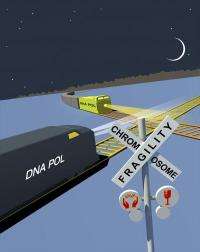Discovery of new class of damage-prone DNA regions could lead to better cancer treatments

Cancer is thought to arise from DNA damage at fragile sites in the genome. A study published by Cell Press on January 24th in the journal Cell reveals a new class of fragile sites that contributes to DNA alterations in a type of blood cancer called B cell lymphoma The findings could lead to the development of more effective treatments for B cell lymphoma and potentially other cancers.
"This study describes an underlying mechanism of genome instability in B cell lymphoma that could not be previously explained," says senior study author André Nussenzweig of the National Cancer Institute. "The phenomena that we show in mice may be important for cancer initiation and progression in humans."
DNA damage can occur at fragile sites when DNA is replicated prior to cell division, and regions that are hard to copy, such as repetitive sequences, are especially prone to double-strand breaks. Because immune system cells called B cell lymphocytes are among the most rapidly dividing cells, they are at great risk for replication-induced DNA damage. In addition, in the nonreplicative stage of the cell cycle, B cell lymphocytes can acquire double-strand breaks through the action of an enzyme that helps build antibody genes called activation-induced cytidine deaminase (AID), which causes a lot of collateral damage in the genome, storing up problems that get exacerbated during replication. But AID activity cannot account for many mutations associated with B cell lymphoma.
In the new study, Nussenzweig and his team uncovered an AID-independent source of DNA breaks associated with replication called early replicating fragile sites (ERFSs). Applying a genome-wide sequencing approach to mouse B cell lymphocytes, they found that DNA damage occurs at ERFSs during early stages of replication. Moreover, these sites overlapped significantly with DNA alterations associated with B cell lymphoma, suggesting that ERFSs are a major feature of the mutational landscape of this type of cancer and possibly other cancers.
"Cancer is an evolving disease, and DNA damage associated with replication is one of the processes occurring in malignant cells to help them adapt and survive when a tumor metastasizes," Nussenzweig says. "Therefore, understanding how replication-induced DNA damage occurs in both healthy and cancer cells may provide a better understanding of how cancer arises and help in designing more effective treatments."
More information: Cell, Nussenzweig et al.: "A novel class of early replicating fragile sites that contribute to genome instability in B cell lymphomas." dx.doi.org/10.1016/j.cell.2013.01.006












